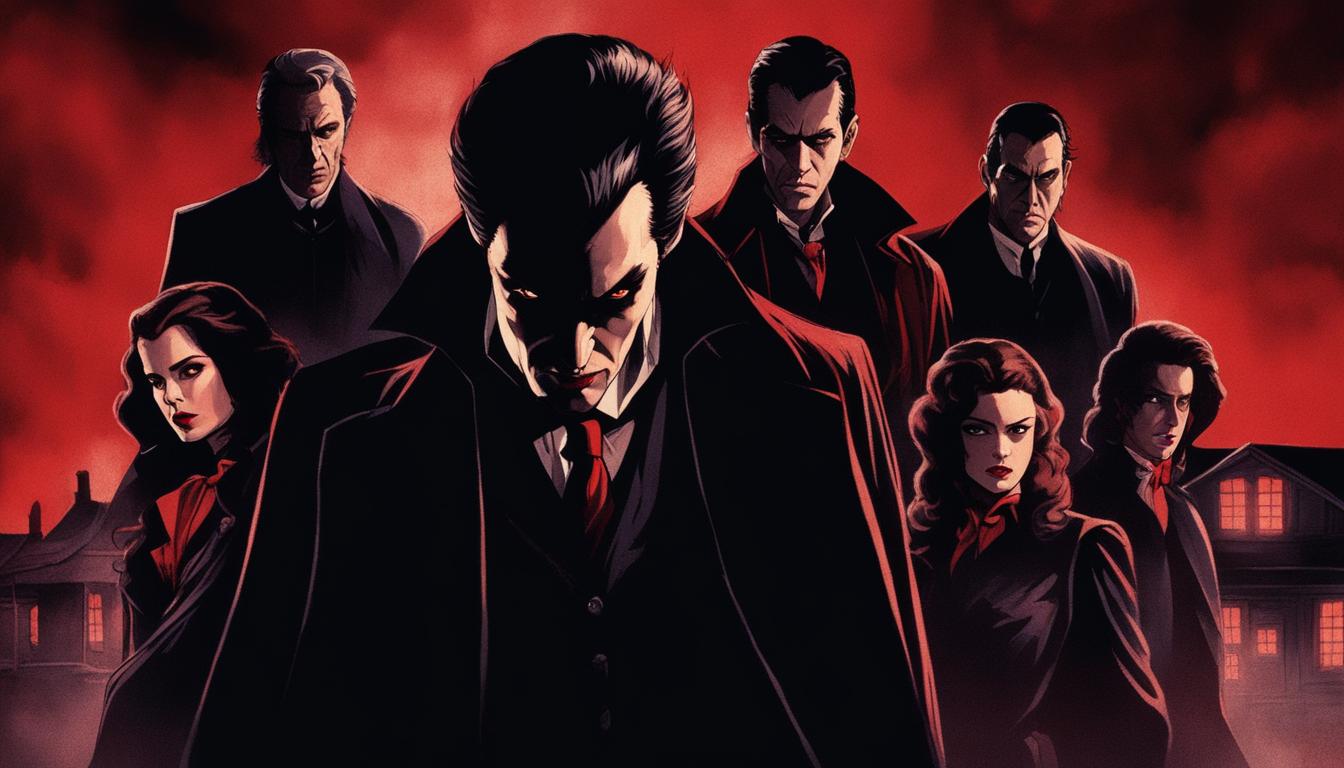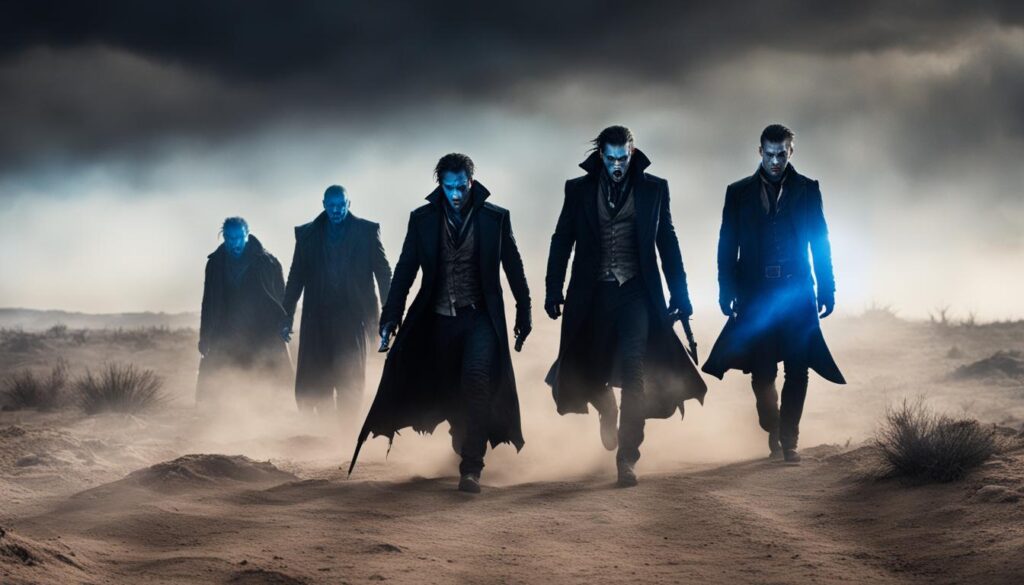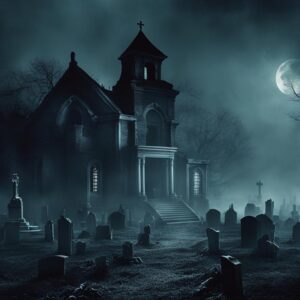Are you ready to venture into the dark and mysterious world of vampires? Look no further than Near Dark (1987), a vampire movie that has earned its place as a cult classic in the horror film genre. Directed by the talented Kathryn Bigelow, this film delivers a spine-chilling and captivating experience that will leave you on the edge of your seat.
Key Takeaways:
- Near Dark (1987) is a cult classic vampire movie directed by Kathryn Bigelow.
- The film features a talented cast, including Adrian Pasdar, Jenny Wright, Lance Henriksen, and Bill Paxton.
- It successfully blends elements of the horror and western genres, creating a unique and thrilling viewing experience.
- Near Dark (1987) takes a fresh and unique approach to portraying vampires, stripping away traditional mythology.
- The film’s atmospheric storytelling, memorable performances, and visual aesthetic contribute to its enduring popularity.
A Chilling Vampire Western
Near Dark (1987) is a unique vampire movie that blends elements of the Western genre with the horror film genre. Directed by Kathryn Bigelow, the film has gained a cult following over the years and is recognized as a standout example of the vampire western subgenre.
The movie takes audiences on a thrilling journey through the American Midwest, as a young cowboy named Caleb Colton becomes entangled with a group of vampires. The film’s atmospheric storytelling, combined with its gritty and desolate setting, creates a chilling and suspenseful viewing experience.
What sets Near Dark apart from other vampire movies is its seamless integration of Western elements. The film incorporates classic Western tropes such as gunfights, dusty landscapes, and a sense of lawlessness, while still delivering the intense horror and supernatural elements expected from the genre. This unique fusion of genres adds a fresh and compelling twist to the vampire movie formula.
| Element | Description |
|---|---|
| Vampire | The film features an unconventional portrayal of vampires, depicting them as gritty and violent outlaws roaming the American West. |
| Western | Near Dark incorporates classic Western elements such as cowboys, desert settings, and gunfights, creating a distinct blend of genres. |
| Horror | The film delivers the expected horror elements of bloodsucking vampires, thrilling suspense, and intense action sequences. |
| Cult Classic | Over the years, Near Dark has gained a dedicated following and is regarded as a cult classic in both the vampire movie and horror film genres. |
Kathryn Bigelow’s direction further elevates the film, showcasing her talent for crafting tense and visually striking scenes. Her unique vision and attention to detail make Near Dark a visually captivating experience.
With its blend of genres, unforgettable performances, and chilling atmosphere, Near Dark (1987) continues to captivate audiences and solidify its status as a vampire movie classic.
The Plot of Near Dark (1987)
In Near Dark (1987), the plot revolves around Caleb Colton, a young cowboy who finds himself entangled with a group of vampires. After being bitten by a vampire named Mae, Caleb is kidnapped and thrust into the underground world of the vampire clan. Faced with the choice of embracing his newfound immortality or finding a way to save himself and Mae, Caleb must navigate the dark and dangerous lifestyle of the vampires.
The film explores themes of love, loyalty, and survival as Caleb wrestles with his own humanity while being drawn deeper into the vampire world. As Caleb learns the rules of the vampire clan and witnesses the brutal and violent acts they commit, he must confront his own moral compass and decide where he truly belongs.
Throughout the movie, Caleb’s relationship with Mae unfolds, adding a layer of emotional depth to the plot. Their bond is tested as Caleb struggles to come to terms with his own transformation and the consequences that come with it.
The Dark and Atmospheric World of Near Dark
The plot of Near Dark (1987) is brought to life through the film’s dark and atmospheric setting. Director Kathryn Bigelow masterfully creates a sense of unease and tension, immersing viewers in the eerie world of the vampire clan. The film’s cinematography captures the desolate landscapes of the American Midwest, heightening the sense of isolation and danger that Caleb faces.
With its unique blend of horror, western, and romance elements, the plot of Near Dark (1987) offers a fresh take on the vampire movie genre. It challenges traditional vampire mythology and delves into the internal struggles and complexities of its characters. This, coupled with the film’s visual aesthetic and captivating performances, makes Near Dark a cult classic that continues to captivate audiences to this day.
The Impact and Legacy of Near Dark (1987)
Near Dark (1987), despite not being a box office success upon its release, has had a significant impact on the vampire movie and horror film genres. Over the years, the film has garnered a strong cult following and is now considered a cult classic. Its unique blend of genres and atmospheric storytelling continue to resonate with audiences and inspire filmmakers.
The legacy of Near Dark extends beyond its initial reception. The film’s portrayal of vampires as more human and relatable characters, as opposed to the traditional supernatural beings, was a fresh take on the genre. This approach added depth and complexity to the story, challenging the conventions of vampire mythology. It opened up new possibilities for future vampire films and helped redefine the representation of vampires in popular culture.
“Near Dark (1987) offers a gritty and unconventional depiction of vampires, creating a sense of unease and tension that lingers with viewers long after the credits roll.”
The impact of Near Dark can also be seen in the careers of its cast and crew. Director Kathryn Bigelow’s debut film showcased her talent and unique vision, setting the stage for her future successes in the film industry. The performances of Adrian Pasdar, Jenny Wright, Lance Henriksen, and Bill Paxton were also praised by critics and have become memorable highlights of the film.
Overall, Near Dark (1987) remains a significant entry in the vampire movie genre. Its impact and legacy are evident in its enduring cult status, its influence on subsequent vampire films, and its ability to captivate audiences with its distinctive approach to storytelling.
Kathryn Bigelow’s Directorial Debut
Kathryn Bigelow made her directorial debut with the vampire movie Near Dark in 1987. This cult classic horror film marked the beginning of Bigelow’s successful career in the film industry. Through her distinctive style and storytelling abilities, she established herself as a visionary director with a unique perspective on the vampire genre.
With Near Dark, Bigelow showcased her talent for blending genres and creating atmospheric narratives. The film’s dark and gritty tone, combined with its exploration of themes such as love, family, and survival, captivated audiences and set it apart from other vampire movies of its time.
Bigelow’s directorial debut in Near Dark paved the way for her future successes, including becoming the first woman to win the Academy Award for Best Director for her film The Hurt Locker in 2010. Her work in Near Dark demonstrated her ability to craft compelling stories and create a lasting impact on the horror and vampire genres.
Through her directorial debut in Near Dark, Kathryn Bigelow established herself as a talented filmmaker with a unique vision. Her contributions to the vampire movie and horror film genres continue to be celebrated, making Near Dark a must-watch for fans of her work and the genre as a whole.
Memorable Performances in Near Dark (1987)
Near Dark (1987) features a talented ensemble cast who deliver memorable performances, bringing depth and nuance to their characters. Adrian Pasdar shines as Caleb Colton, the young cowboy who becomes entangled with the vampire clan. Pasdar effectively portrays Caleb’s transformation from a naive and innocent young man to a conflicted individual struggling with his new reality.
Jenny Wright delivers a captivating performance as Mae, the vampire who bites Caleb and introduces him to the world of bloodsuckers. Wright brings a sense of vulnerability and complexity to the character, making her a standout presence in the film. Her chemistry with Pasdar is palpable, adding an emotional depth to their relationship.
Lance Henriksen and Bill Paxton also deliver standout performances as part of the vampire clan. Henriksen portrays Jesse Hooker, the charismatic and ruthless leader of the group, while Paxton embodies the wild and unpredictable nature of Severen. Both actors bring a sense of danger and intensity to their roles, leaving a lasting impression on viewers.
The Cast of Near Dark (1987)
| Actor | Character |
|---|---|
| Adrian Pasdar | Caleb Colton |
| Jenny Wright | Mae |
| Lance Henriksen | Jesse Hooker |
| Bill Paxton | Severen |
These memorable performances contribute to the overall impact and enduring popularity of Near Dark (1987). The actors’ nuanced portrayals of their characters add depth and complexity to the film, elevating it beyond a typical vampire movie. Their chemistry and talent bring Kathryn Bigelow’s vision to life, making Near Dark a cult classic in the horror film genre.
The Unique Approach to Vampires in Near Dark (1987)
Near Dark (1987) takes a unique and refreshing approach to portraying vampires, defying the traditional mythology surrounding these creatures of the night. Unlike typical vampire movies that depict them as monstrous, immortal beings, Near Dark presents vampires as more human and relatable characters.
In the world of Near Dark, vampires are not simply bloodthirsty killers, but individuals struggling with their own inner demons and desires. They possess human emotions, vulnerabilities, and even the need to form connections and relationships. This unique approach adds depth and complexity to the story, allowing audiences to empathize with the characters and see beyond their supernatural nature.
The film challenges the stereotypes and conventions of the vampire genre, daring to explore the humanity within these nocturnal creatures and questioning our preconceived notions of good and evil.
By humanizing vampires, Near Dark offers a fresh perspective on the age-old legend and delves into themes of redemption, loyalty, and the struggle between one’s darker impulses and their capacity for compassion. It forces us to confront our own prejudices and biases, challenging the black-and-white dichotomy of good versus evil.
Through its unique approach to vampires, Near Dark has become a cult classic in the vampire movie and horror film genres. It stands as a testament to the power of storytelling to subvert expectations, redefine established tropes, and invite audiences to question the boundaries of our own understanding. Discovering this film is an invitation to explore the multifaceted nature of the human experience, even within the supernatural.
A Blend of Genres in Near Dark (1987)
Near Dark (1987) is a vampire movie that stands out from others in the genre due to its unique blending of genres. Directed by Kathryn Bigelow, the film successfully combines elements of vampire horror, western, and thriller, creating a captivating viewing experience that sets it apart as a cult classic.
In Near Dark (1987), the vampire story is merged with the Western genre, giving the film a distinct flavor. The desolate landscapes of the American Midwest serve as the backdrop for the atmospheric storytelling, evoking a sense of isolation and grit. This blending of genres adds depth and richness to the narrative, keeping audiences engaged from beginning to end.
The film’s exploration of the vampire mythology also takes a fresh and innovative approach. Near Dark (1987) strips away the traditional supernatural elements often associated with vampires and presents them as more human and relatable characters. This unique perspective adds an extra layer of complexity to the story, making it more than just a typical vampire movie.
With its blend of genres, Near Dark (1987) offers an unforgettable cinematic experience that continues to captivate audiences to this day. It’s a must-watch for fans of vampire movies, horror films, and those seeking a fresh take on the genre.
“Near Dark (1987) successfully blends vampire horror, western, and thriller genres, creating a unique and captivating viewing experience.”
Cinematic Influences on Near Dark (1987)
As a cult classic vampire movie and horror film, Near Dark (1987) draws inspiration from various cinematic influences. Its unique blend of genres and atmospheric storytelling can be attributed to the creative vision of director Kathryn Bigelow. The film’s visual style and narrative elements pay homage to classic westerns, film noir, and contemporary horror films, creating a captivating viewing experience for audiences.
Film Noir
One of the cinematic influences on Near Dark (1987) is film noir. The genre’s dark and moody visual style is reflected in the film’s atmospheric cinematography and lighting. The use of shadows and contrasting light adds an element of mystery and tension to the narrative, enhancing the overall sense of unease. These stylistic choices contribute to the film’s unique aesthetic, making it a standout example of the vampire movie genre.
Classic Westerns
Near Dark (1987) also pays homage to classic westerns in its portrayal of the American Midwest landscape and its blending of western and vampire elements. The desolate and rugged environments mirror those often seen in western films, creating a sense of isolation and danger. Additionally, the film explores themes of rebellion and the struggle between lawlessness and redemption, further aligning it with the western genre.
Contemporary Horror Films
The influence of contemporary horror films is evident in Near Dark (1987) as well. The film’s depiction of vampires as more human and relatable characters challenges traditional vampire mythology, much like other horror films of the time. This departure from conventions allowed the film to resonate with audiences and contribute to its cult following. It also paved the way for future vampire films to explore new themes and ideas within the genre.
| Cinematic Influences | Description |
|---|---|
| Film Noir | Reflects the dark and moody visual style of film noir through atmospheric cinematography and lighting. |
| Classic Westerns | Pays homage to classic westerns through the portrayal of American Midwest landscapes and the blending of western and vampire elements. |
| Contemporary Horror Films | Draws influence from contemporary horror films by presenting vampires as more human and relatable characters, challenging traditional vampire mythology. |
These cinematic influences contribute to Near Dark’s (1987) enduring legacy as a cult classic. The film’s unique approach to storytelling, visual aesthetic, and genre-blending have made it a standout entry in the vampire movie and horror film genres. By drawing inspiration from various cinematic influences, Near Dark has carved its own place in cinematic history.
The Visual Aesthetic of Near Dark (1987)
The visual aesthetic of Near Dark (1987) plays a crucial role in enhancing the film’s atmospheric storytelling. From the desolate landscapes of the American Midwest to the use of lighting and color, every visual element is carefully crafted to create a sense of unease and tension. The cinematography captures the bleakness of the characters’ world, immersing the audience in their dangerous and shadowy existence.
The film’s use of lighting is particularly notable. The contrast between darkness and light is employed to great effect, highlighting the characters’ struggle between their human and vampire sides. The dimly lit interiors and the stark brightness of the sun are skillfully used to create a sense of impending danger and claustrophobia. These visual choices contribute to the overall sense of unease and unpredictability that permeates the film.
In addition to the cinematography and lighting, the use of color also adds depth and richness to the film’s narrative. Near Dark (1987) employs a muted color palette, with earthy tones dominating the visual landscape. This color scheme enhances the gritty and realistic portrayal of the characters’ world, emphasizing the raw and primal nature of their existence.
Overall, the visual aesthetic of Near Dark (1987) is a key component of the film’s success as a cult classic. The careful attention to detail in the cinematography, lighting, and color choices helps to create a visually striking and immersive experience for the audience. It is through these visual elements that the film is able to effectively convey the dark and atmospheric world of the vampire movie genre.
Near Dark (1987) and the Evolution of the Vampire Genre
Near Dark (1987) stands as a seminal film in the vampire movie genre, pushing the boundaries of traditional vampire mythology and ushering in a new era of storytelling. Directed by Kathryn Bigelow, the film represents an evolution in the genre, deviating from the expected tropes and creating a unique and captivating viewing experience.
One of the most notable aspects of Near Dark is its departure from the traditional portrayal of vampires as supernatural creatures with immortality and superhuman abilities. Instead, the film presents vampires as more human and relatable characters, exploring their vulnerabilities, struggles, and complex relationships. This approach adds depth and realism to the story, challenging the audience’s preconceptions and offering a fresh take on the vampire mythos.
In addition to reimagining the vampire archetype, Near Dark also blends multiple genres to create a wholly unique cinematic experience. By infusing elements of the Western, horror, and thriller genres, the film breaks new ground and captivates viewers with its atmospheric storytelling and intense action sequences. The seamless integration of these genres adds layers of complexity to the narrative and sets the film apart from its contemporaries.
Furthermore, Near Dark’s impact on the vampire genre extends beyond its initial release. The film’s innovative approach to storytelling and characterization has influenced subsequent vampire films, inspiring filmmakers to explore new themes, subvert expectations, and push the boundaries of the genre. Its enduring popularity among fans and its recognition as a cult classic are a testament to its lasting impact on the vampire movie genre.
The Cultural Significance of Near Dark (1987)
Near Dark (1987) holds immense cultural significance as a cult classic in the vampire movie and horror film genres. The film’s exploration of themes such as otherness, rebellion, and family dynamics resonates with audiences, making it a timeless and thought-provoking piece of cinema. Near Dark not only pushed the boundaries of the vampire genre but also challenged conventional storytelling techniques, paving the way for future filmmakers to experiment and innovate.
stands out as a testament to the power of independent filmmaking. It embodies the raw and gritty nature of the 1980s, capturing the essence of the era through its atmospheric cinematography and hauntingly beautiful visuals. The film’s dark and brooding aesthetic creates an immersive experience for the audience, enhancing the overall impact of the story.
One of the most significant aspects of Near Dark (1987) is its portrayal of vampires. Departing from the traditional supernatural beings, the film humanizes the vampires and explores their struggles as outsiders. This unique approach not only adds depth to the characters but also challenges societal norms and prejudices, leading viewers to question their own perceptions of good and evil.
Through its artistic vision and powerful storytelling, Near Dark (1987) has left an indelible mark on the cultural landscape. It continues to be celebrated and appreciated, inspiring generations of filmmakers and captivating audiences with its timeless themes and unforgettable characters. The film’s cultural significance can be attributed to its ability to transcend genres and deliver a profound and resonant cinematic experience.
Conclusion
Near Dark (1987) is a vampire movie that has cemented its place as a cult classic in the horror film genre. Directed by Kathryn Bigelow, this film stands out for its unique blend of vampire mythology and Western tropes, creating a captivating viewing experience. The performances from the cast, including Adrian Pasdar, Jenny Wright, Lance Henriksen, and Bill Paxton, leave a lasting impression.
What sets Near Dark apart from other vampire films is its fresh approach to portraying vampires. The film strips away the traditional supernatural elements and presents vampires as more relatable and human characters. This unique take adds depth and complexity to the story, making it a standout entry in the genre.
The impactful direction of Kathryn Bigelow, combined with the blending of genres and the visually striking aesthetic, elevates Near Dark to cult classic status. It has influenced the evolution of the vampire genre and remains culturally significant. For fans of vampire movies and horror films, Near Dark (1987) is a must-watch that showcases the talent and creativity of its director and cast.
FAQ
Is Near Dark (1987) considered a cult classic?
Yes, Near Dark (1987) is considered a cult classic in the horror film genre.
Who directed Near Dark (1987)?
Near Dark (1987) was directed by Kathryn Bigelow.
Who are the main cast members of Near Dark (1987)?
The main cast members of Near Dark (1987) include Adrian Pasdar, Jenny Wright, Lance Henriksen, and Bill Paxton.
What is the plot of Near Dark (1987)?
Near Dark (1987) follows Caleb Colton, a young cowboy who becomes involved with a group of vampires and must navigate their dangerous lifestyle while trying to save himself and the vampire who bit him, Mae.
Was Near Dark (1987) a box office success?
Near Dark (1987) did not achieve significant box office success upon its initial release but has gained a strong cult following over the years.
What is the unique aspect of Near Dark (1987) that sets it apart from other vampire movies?
Near Dark (1987) presents vampires as more human and relatable characters, deviating from traditional vampire mythology.
What genres does Near Dark (1987) blend?
Near Dark (1987) blends vampire horror, western, and thriller genres, creating a unique and captivating viewing experience.
What are the cinematic influences on Near Dark (1987)?
Near Dark (1987) draws inspiration from classic westerns, film noir, and contemporary horror films.
How did Near Dark (1987) impact the vampire genre?
Near Dark (1987) explored new themes and ideas within the vampire genre, contributing to its evolution and inspiring subsequent vampire films.
Does Near Dark (1987) have any cultural significance?
Yes, Near Dark (1987) holds cultural significance as a standout entry in the vampire movie and horror film genres, resonating with audiences through its exploration of themes such as otherness, rebellion, and family dynamics.







